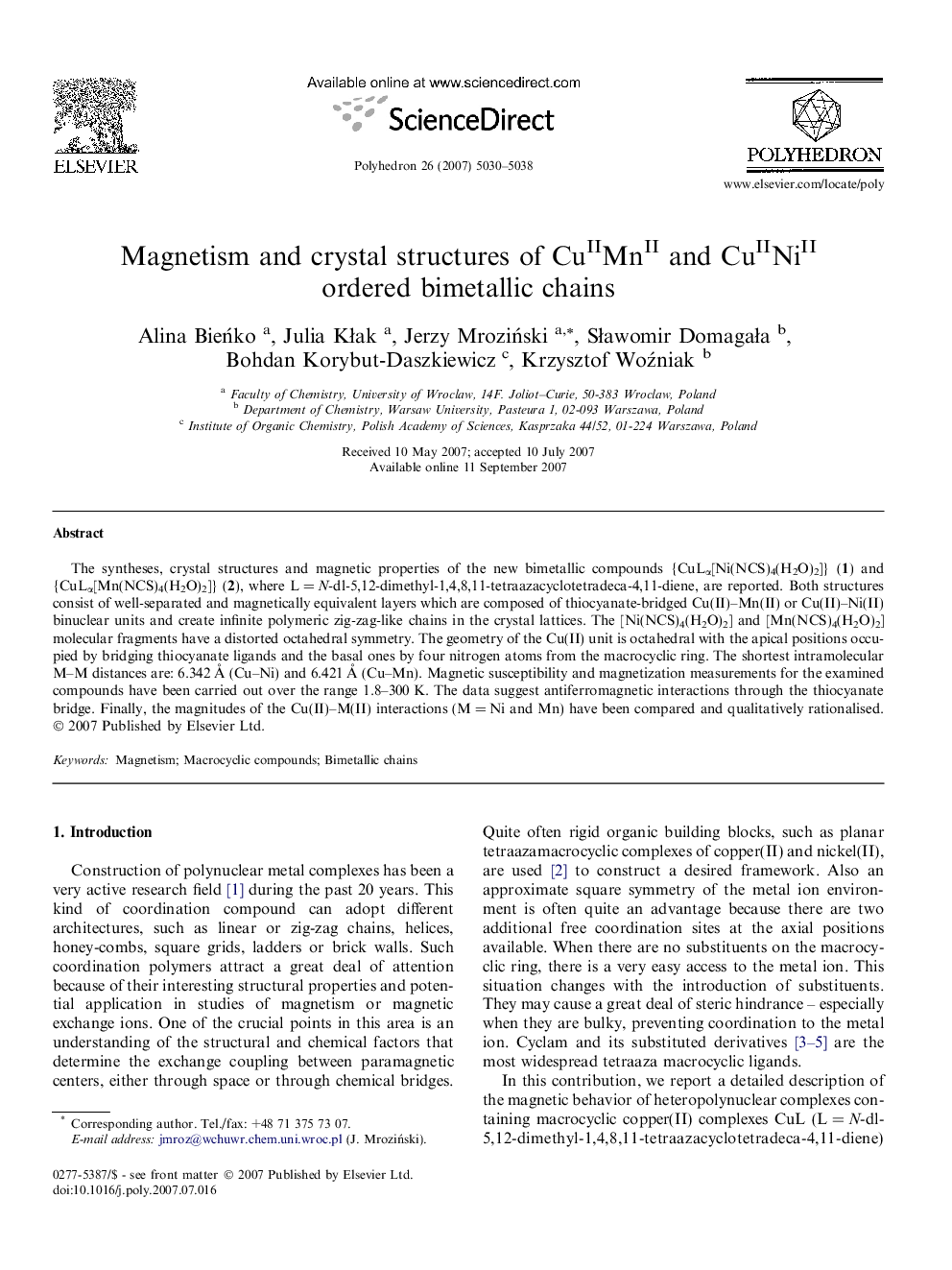| کد مقاله | کد نشریه | سال انتشار | مقاله انگلیسی | نسخه تمام متن |
|---|---|---|---|---|
| 1338029 | 979657 | 2007 | 9 صفحه PDF | دانلود رایگان |

The syntheses, crystal structures and magnetic properties of the new bimetallic compounds {CuLα[Ni(NCS)4(H2O)2]} (1) and {CuLα[Mn(NCS)4(H2O)2]} (2), where L = N-dl-5,12-dimethyl-1,4,8,11-tetraazacyclotetradeca-4,11-diene, are reported. Both structures consist of well-separated and magnetically equivalent layers which are composed of thiocyanate-bridged Cu(II)–Mn(II) or Cu(II)–Ni(II) binuclear units and create infinite polymeric zig-zag-like chains in the crystal lattices. The [Ni(NCS)4(H2O)2] and [Mn(NCS)4(H2O)2] molecular fragments have a distorted octahedral symmetry. The geometry of the Cu(II) unit is octahedral with the apical positions occupied by bridging thiocyanate ligands and the basal ones by four nitrogen atoms from the macrocyclic ring. The shortest intramolecular M–M distances are: 6.342 Å (Cu–Ni) and 6.421 Å (Cu–Mn). Magnetic susceptibility and magnetization measurements for the examined compounds have been carried out over the range 1.8–300 K. The data suggest antiferromagnetic interactions through the thiocyanate bridge. Finally, the magnitudes of the Cu(II)–M(II) interactions (M = Ni and Mn) have been compared and qualitatively rationalised.
The syntheses, crystal structures and magnetic properties of the new bimetallic compounds {CuLα[Ni(NCS)4(H2O)2]} (1) and {CuLα[Mn(NCS)4(H2O)2]} (2), where L = N-dl-5,12-dimethyl-1,4,8,11-tetraazacyclotetradeca-4,11-diene, are reported. Both structures consist of well-separated and magnetically equivalent layers which are composed of thiocyanate-bridged Cu(II)–Mn(II) or Cu(II)–Ni(II) binuclear units and create infinite polymeric zig-zag-like chains in the crystal lattices. The [Ni(NCS)4(H2O)2] and [Mn(NCS)4(H2O)2] molecular fragments have a distorted octahedral symmetry. The geometry of the Cu(II) unit is octahedral with the apical positions occupied by bridging thiocyanate ligands and the basal ones by four nitrogen atoms from the macrocyclic ring. The shortest intramolecular M–M distances are: 6.342 Å (Cu–Ni) and 6.421 Å (Cu–Mn). Magnetic susceptibility and magnetization measurements for the examined compounds have been carried out over the range 1.8–300 K. The data suggest antiferromagnetic interactions through the thiocyanate bridge. Finally, the magnitudes of the Cu(II)–M(II) interactions (M = Ni and Mn) have been compared and qualitatively rationalised.Figure optionsDownload as PowerPoint slide
Journal: Polyhedron - Volume 26, Issue 17, 30 October 2007, Pages 5030–5038